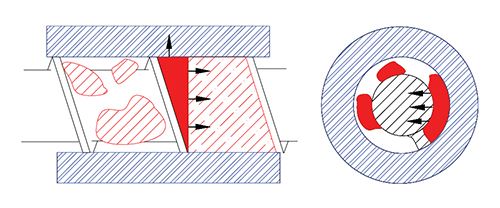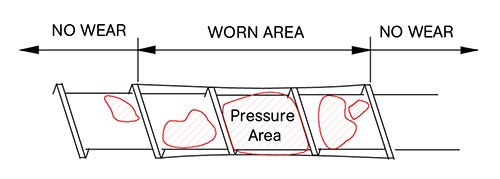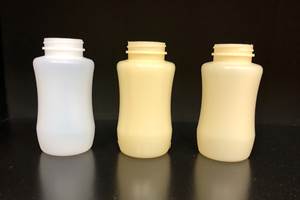The Cause of Catastrophic Screw Wear
Erratic feeding can be the culprit. This is not uncommon when dealing with recycled material.
I frequently come across catastrophic wear when I’m examining screws used in a recycling process. Recycling presents some issues not generally found in traditional extrusion operations that rely on pelletized polymers, even when these conventional processes use high percentages of regrind. That’s because the film, fiber, foam, or bottle scrap fed into recycling extruders often has low bulk density and non-free-flowing characteristics. Whether the extruder is fed by gravity or with a side feeder, crammer, or stuffer, there is always some inconsistency in the feed uniformity due to the erratic characteristics of these feedstocks.
Most processors intuitively know how much force a screw jack or even a bolt can exert, but they do not realize that the same principle applies to the extruder screw. The screw is actually an inclined plane or wedge that’s wound spirally around a cylinder in a helical form. This design creates an action just like a wedge and multiplies the force of the screw drive. For a standard flight pitch, the multiplier is about four times the torque of the drive, not taking friction into account.
The localized forces acting in a single-screw extruder are enormous when the polymer is still in solid form. When the screw is fed inconsistently, it is alternately full and partially full at different locations until compaction is fully completed farther down the screw. Areas that are full will develop pressure from the wedge action, because solid polymer does not slide easily on the barrel wall. That results in pressure in the polymer and an unbalanced force on the screw. This pushes the screw in in the opposite direction and presses it against the barrel wall with enormous force because of the small resisting area of the screw flight (see Fig 1).
Although these forces cannot be observed from outside the extruder, there is no question they exist. Otherwise, how could you explain a screw that is worn over a short distance and yet essentially unworn before and after that area. In order to wear in that pattern, the screw has to bend over that distance. I recently investigated a case in which a 6-in. screw was experiencing catastrophic wear in only three diameters near the end of the feed section (Fig. 2). I calculated the side force necessary to bend a shaft having that root diameter enough to permit that amount of deflection: It was about 60,000 lb. And that was assuming no bending support from the screw flights, which do greatly strengthen the screw in bending—meaning the actual force was much more.
There are two types of “wedging.” There is a distinct difference between the wear caused by erratic feeding and the wear due to insufficient melting capability. Wedging due to inadequate feeding is generally contained to the feed section and first turn of the compression section. On the other hand, wedging due to inadequate melting capacity can cause the compression section (barrier section) to temporarily plug with solids and cause an unbalanced force on the screw. That form of wedging is usually contained in the latter half of the compression section. Melt-limited wedging causes accelerated wear but generally not catastrophic wear, because the screw is filled and there is some support from the opposite side, depending on the degree of melting.
Some operating practices—such as manually dumping bales of film scrap into the hopper—really accelerate the wear as the screw alternatively runs full and empty, causing large moving side forces. Letting the screw run empty and then suddenly filling it at full speed will have the same effect. Less severe but still very problematic are the use of feed-assist devices such as crammers, stuffers, and side feeders that are not designed and/or operated properly.
If catastrophic wear is occurring in the feed section or early part of the compression section, consider stabilizing the feed rate into the screw. This may require additional polymer grinding or changes in design of the screw or any apparatus that assists in the feeding recycled polymer into the screw.
As a guideline, when the feed rate into the screw is erratic there will be evidence in continuous variation in the motor amps with a proportional change in head pressure at the same frequency. The forces are so great that the use of premium screw and barrel materials will only have a minor effect on the wear rate.
Related Content
How to Extrusion Blow Mold PHA/PLA Blends
You need to pay attention to the inherent characteristics of biopolymers PHA/PLA materials when setting process parameters to realize better and more consistent outcomes.
Read MoreBreaking News From NPE2024
Here is a firsthand report of news in injection molding, extrusion, blow molding and recycling not previously covered.
Read MoreFoam-Core Multilayer Blow Molding: How It’s Done
Learn here how to take advantage of new lightweighting and recycle utilization opportunities in consumer packaging, thanks to a collaboration of leaders in microcellular foaming and multilayer head design.
Read MoreMultilayer Solutions to Challenges in Blow Molding with PCR
For extrusion blow molders, challenges of price and availability of postconsumer recycled resins can be addressed with a variety of multilayer technologies, which also offer solutions to issues with color, processability, mechanical properties and chemical migration in PCR materials.
Read MoreRead Next
Making the Circular Economy a Reality
Driven by brand owner demands and new worldwide legislation, the entire supply chain is working toward the shift to circularity, with some evidence the circular economy has already begun.
Read MoreSee Recyclers Close the Loop on Trade Show Production Scrap at NPE2024
A collaboration between show organizer PLASTICS, recycler CPR and size reduction experts WEIMA and Conair recovered and recycled all production scrap at NPE2024.
Read More
.jpg;width=70;height=70;mode=crop)





















